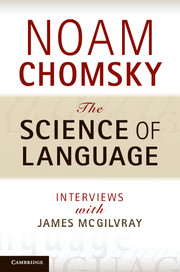Appendices
Published online by Cambridge University Press: 05 June 2012
Summary
Chomsky's notion of an I-language was introduced in part (in 1986) by appeal to a contrast with what he called an “E-language” approach to the study of language. An E-language approach is one that studies language that is ‘externalized.’ One form that externalization might take is found in a philosophers’ favorite, the notion of a public language. What is a public language? David Lewis and Wilfrid Sellars, among many others, assume that a language is an institution shared by individuals in a population, taught by training procedures with the aim of getting the child to conform to the rules for word and sentence usage (for Lewis, “conventions,” and for Sellars, “practices”) of the relevant population. This view turns out to be hopeless as a basis for scientific research for reasons taken up in appendices VI and XI. It does, however, conform quite nicely to a commonsense conception of language.
Another version of an E-language approach is found in Quine, where he insists that there is no “fact of the matter” with regard to deciding between two grammars for ‘a language,’ so long as they are “extensionally equivalent.” To say that they are extensionally equivalent, each would have to generate all and only the same set of sentences, where a sentence is understood to be a ‘string’ of ‘words.’ To make sense of this, one must think that it is possible to identify a language for purposes of scientific investigation with a set – an infinite set – of strings. However, that belief is erroneous, for several reasons that become clear below; essentially, a language is a system in the head that has the competence to generate a potential infinity of sound–meaning pairs, where these pairs are defined by appeal to the theory, as is the recursive procedure that can yield them. What a person actually produces in various contexts during his or her lifetime is a very different creature: in Chomsky's terminology, it is an “epiphenomenon,” not a grouping of strings that can be the subject matter of a naturalistic scientific effort.
- Type
- Chapter
- Information
- The Science of LanguageInterviews with James McGilvray, pp. 153 - 261Publisher: Cambridge University PressPrint publication year: 2012



